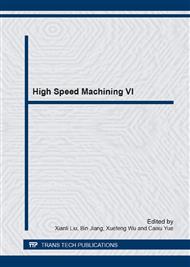[1]
KuanyuanKuo, KunlingWu, ChengkuangYang, BiingHwaYan. Wire electrochemical discharge machining of quartz glass with titratedelectrolyte flow. International Journal of Machine Tools & Manufacture (2013): 50–57.
DOI: 10.1016/j.ijmachtools.2013.06.003
Google Scholar
[2]
Feng B F, Cai G Q and Qiu C W. Development and key technique of ultra-high speed grinding. Mechanical Engineer (2000), (1): 1–3.
Google Scholar
[3]
Ling Yin, H. Huang, K. Ramesh, T. Huang. High speed versus conventional grinding in high removal rate machining ofalumina and alumina–titania. International Journal of Machine Tools & Manufacture 45 (2005): 897–907.
DOI: 10.1016/j.ijmachtools.2004.10.016
Google Scholar
[4]
M.J. Jackson, C.J. Davis, M.P. Hitchiner, B. Mills. High-speed grinding with CBN grinding wheels-applications and future technology. Journal of Materials Processing Technology 110 (2001): 78–88.
DOI: 10.1016/s0924-0136(00)00869-4
Google Scholar
[5]
Xipeng Xu, Yiqing Yu. Sawing performance of diamond with alloy coatings. Surface & Coatings Technology 198 (2005): 459–463.
DOI: 10.1016/j.surfcoat.2004.10.060
Google Scholar
[6]
Tae Jo Ko, Hee Sool Kim. Mechanistic cutting force model in band sawing. Journal of Machine Tools & Manufacture 39 (1999): 1185–1197.
DOI: 10.1016/s0890-6955(98)00087-x
Google Scholar
[7]
Xu X P, LiY andMalkin S. Forces and Energy in Circular Sawing and Grinding of Granite. Transactions of the ASME: Journal of Manufacturing Science and Engineering 123 (2001): 13–22.
DOI: 10.1115/1.1344900
Google Scholar
[8]
Xipeng Xu, Yuan Li, Yiqing Yu. Force Ratio in Circular Sawing of Granite with Diamond SegmentedBlade. Journal of Materials ProcessingTechnology139 (2003): 281–285.
Google Scholar
[9]
C.H. Li, Webber Mao, Y.L. Hou. Investigation of Hydrodynamic Pressure in Highspeed Precision Grinding. Procedia Engineering 15 (2011): 2809–2813.
DOI: 10.1016/j.proeng.2011.08.529
Google Scholar
[10]
U. Atici, A. Ersoy. Correlation of specific energy of cutting saws and drillingbits with rock brittleness and destruction energy. Journal of materials processing technology 209 (2009): 2602–2612.
DOI: 10.1016/j.jmatprotec.2008.06.004
Google Scholar
[11]
Jianyi Chen, Jianyun Shen, Hui Huang, Xipeng Xu. Grinding characteristics in high speed grinding of engineering ceramics withbrazed diamond wheels. Journal of Materials Processing Technology (2010): 899–906.
DOI: 10.1016/j.jmatprotec.2010.02.002
Google Scholar
[12]
A. Ersoy, U. Atici. Performance characteristics of circular diamond saws in cutting differenttypes of rocks. Diamond and Related Materials 13, (2004): 22–37.
DOI: 10.1016/j.diamond.2003.08.016
Google Scholar
[13]
S.Y. Luo. Investigation of the worn surfaces of diamond saw blades in sawing granite. Materials Processing Technology70 (1997): 1–8.
DOI: 10.1016/s0924-0136(97)00033-2
Google Scholar
[14]
Janusz Konstanty. Theoretical analysis of stone sawing with diamonds. Materials Processing Technology 123 (2002): 146–154.
DOI: 10.1016/s0924-0136(02)00071-7
Google Scholar
[15]
Thomas P. James, Joseph P. Study of blade wear in reciprocating sawing. Proceedings of the ASME 2010 International Mechanical Engineering Congress & Exposition, (2010): 1~7.
Google Scholar


